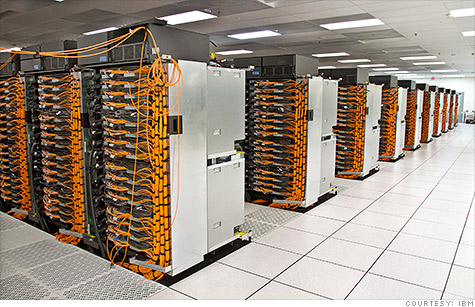Search News

Sequoia, a supercomputer at the Lawrence Livermore National Laboratory in California, is now the world's most powerful machine.
NEW YORK (CNNMoney) -- America is back on top in the race to claim ownership of the world's most powerful supercomputer.
In a ranking released Monday of the world's top 500 supercomputers, the United States scored the top spot with Sequoia, a supercomputer housed at the Department of Energy's Lawrence Livermore National Laboratory in California. The U.S. had been trailing China and Japan in the supercomputer race since June 2010, when a Chinese system took over the No. 1 spot.
Sequoia boasts 1.57 million cores and a capability of 16.32 petaflops, meaning it can process 16.32 quadrillion calculations per second. The No. 2 system, Japan's K computer, can handle a sustained 10.51 petaflops per second.
Scientists are using the world's mightiest computer for nuclear weapons research.
Sequoia was built by IBM (IBM, Fortune 500) for the National Nuclear Security Administration, which uses it to model weapons performance and to "extend the life of aging weapons systems," according to Bob Meisner, NNSA's advanced simulation and computing director.
The newly minted supercomputing champion was years in the making. Work on designing the machine began more than three years ago, said Dave Turek, IBM's vice president of high-performance computing systems. NNSA's scientists began using Sequoia about a month and a half ago.
Turek said he was pleased to see Sequoia grab top spot on the list, which serves as an unofficial guide to the supercomputing "space race" to develop some of the most advanced technology on the planet.
"It is a culmination of a lot of smart people working for a very long time, creating a lot of innovations to get you to this point," Turek said. "There aren't too many players in the world that can build a system like Sequoia."
Half of the global supercomputer list's top 10 comes from IBM, which made 213 of the biannual list's current top 500. Hewlett-Packard (HPQ, Fortune 500) has the second most, with a share representing around 27% of list.
Three of the planet's top 10 systems come from the United States. Two each are from China and Germany, while Japan, Italy and France each claimed one system on the list.
The list, published every June and November, is compiled by researchers at Germany's University of Mannheim, the Lawrence Berkeley National Laboratory and the University of Tennessee at Knoxville.
The world's biggest iron is quickly getting vastly more powerful. The total performance of all the systems on the latest list was 123.4 petaflops per second, a 66% gain on the 74.2 petaflops per second cumulative capacity clocked for the November list issued just six months ago. ![]()